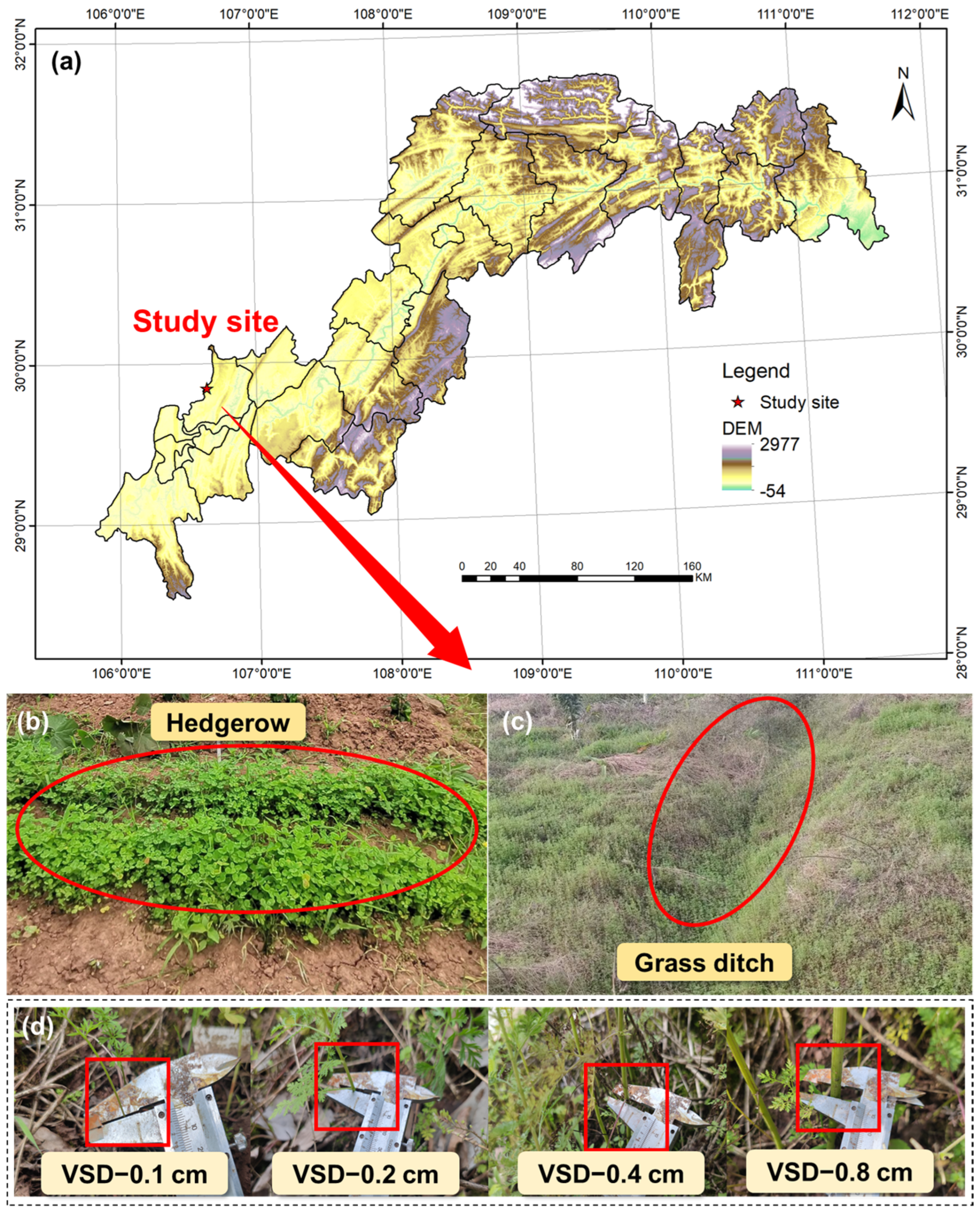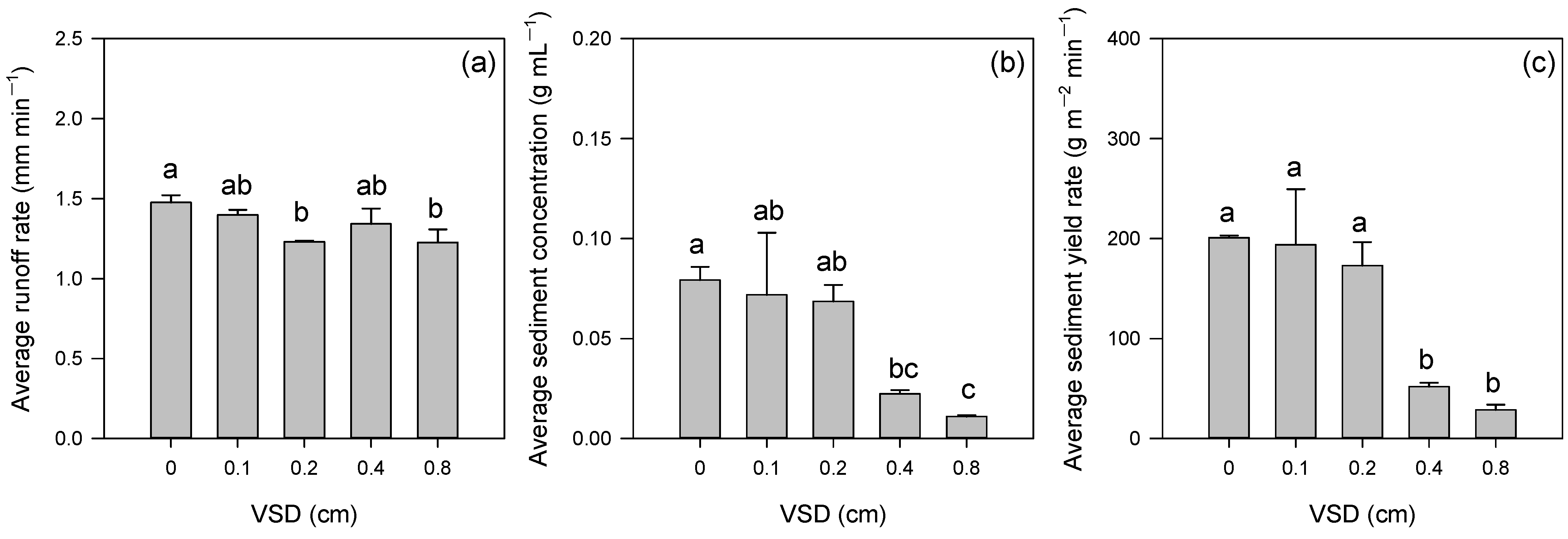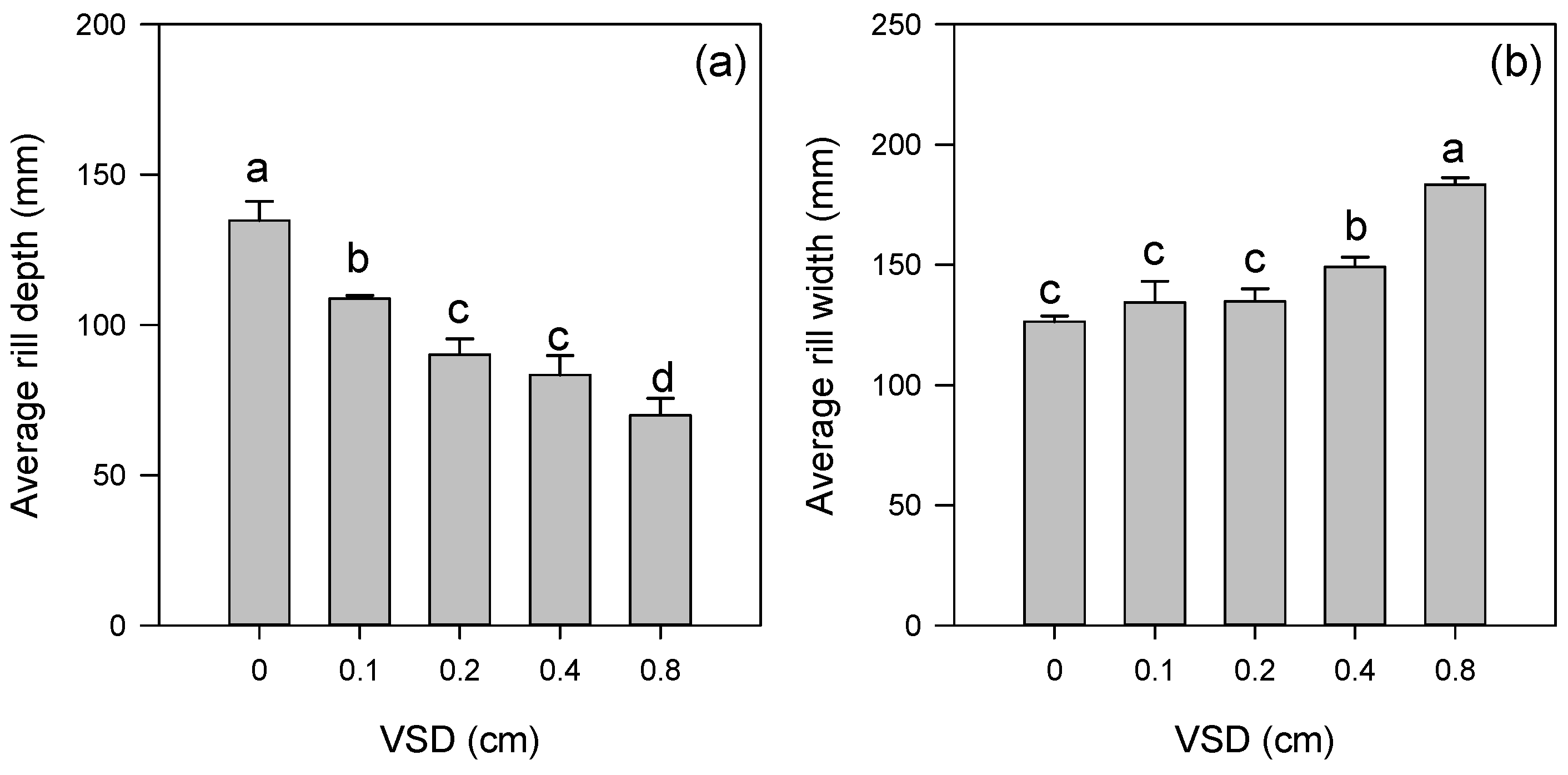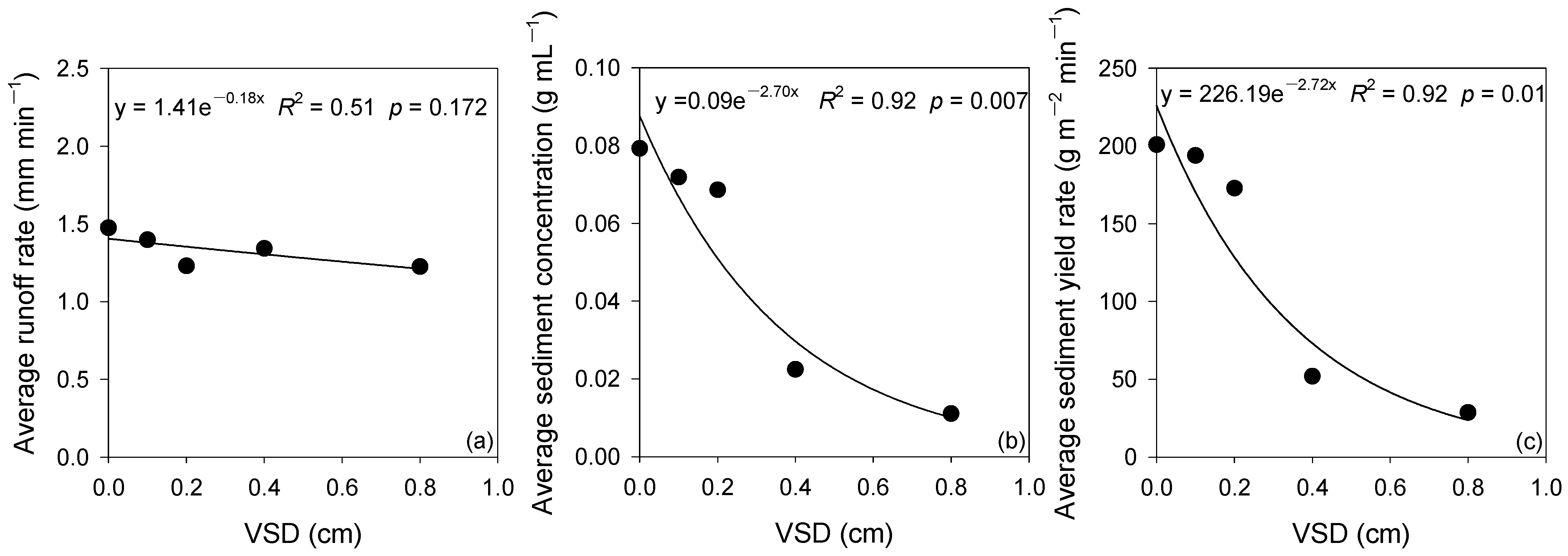Characteristics of Runoff and Sediment Yield in a Simulated Hedgerow–Grass Ditch System in Sloping Lands with Regosols
Abstract
1. Introduction
2. Materials and Methods
2.1. Soil and Rainfall Simulator
2.2. Experiment Design
2.3. Measurements and Calculation
2.4. Statistical Analysis
3. Results
3.1. Rainfall and Soil Erosion Process Simulation
3.2. Reduction in Runoff and Sediment Yield
3.3. Runoff and Sediment Yield Indicators and VSD Model
4. Discussion
5. Conclusions
Author Contributions
Funding
Data Availability Statement
Conflicts of Interest
References
- Li, X.; Zhang, Y.F.; Ji, X.D.; Strauss, P.; Zhang, Z.Q. Effects of shrub-grass cover on the hillslope overland flow and soil erosion under simulated rainfall. Environ. Res. 2022, 214, 113774. [Google Scholar] [CrossRef] [PubMed]
- Kervroëdan, L.; Armand, R.; Saunier, M.; Faucon, M. Effects of plant traits and their divergence on runoff and sediment retention in herbaceous vegetation. Plant Soil 2019, 441, 511–524. [Google Scholar] [CrossRef]
- Eshghizadeh, M.; Talebi, A.; Dastorani, M. Thresholds of land cover to control runoff and soil loss. Hydrol. Sci. J. 2018, 63, 1424–1434. [Google Scholar] [CrossRef]
- Martin, E.R.; Godwin, I.A.; Cooper, R.I.; Aryal, N.; Reba, M.L.; Bouldin, J.L. Assessing the impact of vegetative cover within Northeast Arkansas agricultural ditches on sediment and nutrient loads. Agric. Ecosyst. Environ. 2021, 320, 107613. [Google Scholar] [CrossRef]
- Yao, C.; Chen, K.B.; Zhang, Q.W.; Wang, C.F.; Lu, C.; Wang, H.; Wu, F.Q. The contribution rate of stem-leaf and root of alfalfa (Medicago sativa L.) to sediment and runoff reduction. Land Degrad. Dev. 2023, 34, 3991–4005. [Google Scholar] [CrossRef]
- Salamn, M.; Manochehr, G.; Ali, J. Effect of rock fragments cover on distance of rill erosion initiation and overland flow hydraulics. Int. J. Soil Sci. 2012, 7, 100–107. [Google Scholar] [CrossRef]
- Lou, Y.B.; Kang, H.L.; Wang, W.L.; Guo, M.M.; Zhu, Y.N.; Feng, L.Q.; Shi, Q.H.; Guo, W.Z.; Xu, W.X. Effects of vegetation stem coverage on the hydraulic characteristics and on-wall and jet flow proportions at the gully head. Catena 2023, 229, 107201. [Google Scholar] [CrossRef]
- Cen, Y.D.; Zhang, K.D.; Peng, Y.; Rubinato, M.; Zhang, H.Y.; Shang, H.X.; Li, P. Quantification of the effects on the flow velocity caused by gramineous plants in the Loess Plateau in North-Western China. Geoderma 2023, 429, 116264. [Google Scholar] [CrossRef]
- Tian, P.; Xu, X.Y.; Pan, C.Z.; Hsu, K.; Yang, T.T. Impacts of rainfall and inflow on rill formation and erosion processes on steep hillslopes. J. Hydrol. 2017, 548, 24–39. [Google Scholar] [CrossRef]
- Dunn, R.M.; Zhang, Y.S.; Blackwell, M.S.A.; Hawkins, J.M.B.; Collins, A.L. Impacts of different vegetation in riparian buffer strips on runoff and sediment loss. Hydrol. Process. 2022, 36, e14733. [Google Scholar] [CrossRef]
- Xiao, H.; Xiang, R.; Yan, R.B.; Xia, Z.Y.; Guo, P.; Gao, F.; Zhang, W.Q.; Zhu, Z.E.; Dong, X.H.; Zhang, L.; et al. Evaluating the influences hedgerow on soil erosion and nitrogen loss of purple soil sloping farmland under simulated rainfall. Ecol. Indic. 2024, 158, 111438. [Google Scholar] [CrossRef]
- Lenka, N.K.; Dass, A.; Sudhishri, S.; Patnaik, U.S. Soil carbon sequestration and erosion control potential of hedgerows and grass filter strips in sloping agricultural lands of eastern India. Agric. Ecosyst. Environ. 2012, 158, 31–40. [Google Scholar] [CrossRef]
- Lucke, T.; Mohamed, M.A.K.; Tindale, N. Pollutant Removal and Hydraulic Reduction Performance of Field Grassed Swales during Runoff Simulation Experiments. Water 2014, 6, 1887–1904. [Google Scholar] [CrossRef]
- Li, X.N.; Zhang, W.W.; Zhao, C.Q.; Li, H.J.; Shi, R.S. Nitrogen interception and fate in vegetated ditches using the isotope tracer method: A simulation study in northern China. Agric. Water Manag. 2020, 228, 105893. [Google Scholar] [CrossRef]
- Kumwimba, M.N.; Meng, F.G.; Iseyemi, O.; Moore, M.T.; Bo, Z.; Tao, W.; Liang, T.J.; Ilunga, L. Removal of non-point source pollutants from domestic sewage and agricultural runoff by vegetated drainage ditches (VDDs): Design, mechanism, management strategies, and future directions. Sci. Total Environ. 2018, 639, 742–759. [Google Scholar] [CrossRef] [PubMed]
- Taylor, J.; Moore, M.; Speir, S.L.; Testa, S. Vegetated ditch habitats provide net nitrogen sink and phosphorus storage capacity in agricultural drainage networks despite senescent plant leaching. Water 2020, 12, 875. [Google Scholar] [CrossRef]
- Vymazal, J.; Březinová, T.D. Removal of nutrients, organics and suspended solids in vegetated agricultural drainage ditch. Ecol. Eng. 2018, 118, 97–103. [Google Scholar] [CrossRef]
- Kumwimba, M.N.; Zhu, B.; Wang, T.; Dzakpasu, M.; Li, X.Y. Nutrient dynamics and retention in a vegetated drainage ditch receiving nutrient-rich sewage at low temperatures. Sci. Total Environ. 2020, 741, 140268. [Google Scholar] [CrossRef]
- Gratien, N.; Li, H.; Bao, Y.H.; Jean, D.D.N.; Li, J.L.; Tite, N.; He, X.B. Soil aggregate disintegration effects on soil erodibility in the water level fluctuation zone of the Three Gorges Reservoir, China. Environ. Res. 2023, 217, 114928. [Google Scholar]
- Shi, Z.H.; Yue, B.J.; Wang, L.; Fang, N.F.; Wang, D.; Wu, F.Z. Effects of Mulch Cover Rate on Interrill Erosion Processes and the Size Selectivity of Eroded Sediment on Steep Slopes. Soil Sci. Soc. Am. J. 2013, 77, 257–267. [Google Scholar] [CrossRef]
- Are, K.S.; Oshunsanyab, S.O.; Oluwatosina, G.A. Changes in soil physical health indicators of an eroded land as influenced by integrated use of narrow grass strips and mulch. Soil Tillage Res. 2018, 184, 269–280. [Google Scholar] [CrossRef]
- Bah, H.; Zhou, M.H.; Ren, X.; Hu, L.; Dong, Z.X.; Zhu, B. Effects of organic amendment applications on nitrogen and phosphorus losses from sloping cropland in the upper Yangtze River. Agric. Ecosyst. Environ. 2020, 302, 107086. [Google Scholar] [CrossRef]
- IUSS Working Group. World Reference Base for Soil Resources. International Soil Classification System for Naming Soils and Creating Legends for Soil Maps, 4th ed.; International Union of Soil Sciences (IUSS): Vienna, Austria, 2022. [Google Scholar]
- Du, Y.N.; Li, T.Y.; He, B.H. Runoff-related nutrient loss affected by fertilization and cultivation in sloping croplands: An 11-year observation under natural rainfall. Agric. Ecosyst. Environ. 2021, 319, 107549. [Google Scholar] [CrossRef]
- Bai, L.L.; Shi, P.; Li, Z.B.; Li, P.; Zhao, Z.; Dong, J.B.; Cui, L.Z. Effects of vegetation patterns on soil nitrogen and phosphorus losses on the slope-gully system of the Loess Plateau. J. Environ. Manag. 2022, 324, 116288. [Google Scholar] [CrossRef]
- Shen, H.B.; Xu, Z.X.; Zhang, Q.; Zhang, S.H. Reduction of runoff-sediment-pollutants and correlation analysis in grass swale. J. Beijing Norm. Univ. (Nat. Sci.) 2019, 55, 641–647, (In Chinese with English Abstract). [Google Scholar]
- Sun, L.Q.; Zhang, B.; Yin, Z.M.; Guo, H.L.; Siddique, K.H.M.; Wu, S.F.; Yang, J.T. Assessing the performance of conservation measures for controlling slope runoff and erosion using field scouring experiments. Agric. Water Manag. 2022, 259, 107212. [Google Scholar] [CrossRef]
- Li, T.Y.; Li, S.Y.; Liang, C. The immediate effects of downslope cornstalk mulch (DCM) on sediment yield, runoff and runoff-associated dissolved carbon loss in a representative hillslope, Southwestern China. Catena 2019, 175, 9–17. [Google Scholar] [CrossRef]
- Duan, J.; Liu, Y.J.; Wang, L.Y.; Yang, J.; Tang, C.J.; Zheng, H.J. Importance of grass stolons in mitigating runoff and sediment yield under simulated rainstorms. Catena 2022, 213, 106132. [Google Scholar] [CrossRef]
- Shi, P.; Li, P.; Li, Z.B.; Sun, J.M.; Wang, D.J.; Min, Z.Q. Effects of grass vegetation coverage and position on runoff and sediment yields on the slope of Loess Plateau, China. Agric. Water Manag. 2022, 259, 107231. [Google Scholar] [CrossRef]
- Han, D.D.; Deng, J.C.; Gu, C.J.; Mu, X.M.; Gao, P.; Gao, J.J. Effect of shrub-grass vegetation coverage and slope gradient on runoff and sediment yield under simulated rainfall. Int. J. Sediment Res. 2021, 36, 29–37. [Google Scholar] [CrossRef]
- Mu, H.L.; Fu, S.H. Comparison of the influences of vegetation stem parameters on hydraulic variables and sediment transport capacity. Int. Soil Water Conserv. Res. 2023, 11, 135–144. [Google Scholar] [CrossRef]
- Mu, H.L.; Yu, X.J.; Fu, S.H.; Yu, B.F.; Liu, Y.N.; Zhang, G.H. Effect of stem basal cover on the sediment transport capacity of overland flows. Geoderma 2019, 337, 384–393. [Google Scholar] [CrossRef]
- Bai, L.L.; Shi, P.; Li, Z.B.; Li, P.; Zhao, Z.; Dong, J.B.; Cui, L.Z. Grass coverage and the runoff path length decreased by sedimentation have synergistic effects on runoff and sediment yields in a slope-gully system, revealed by rainfall simulation experiments. Catena 2022, 218, 106577. [Google Scholar] [CrossRef]
- Lin, Q.T.; Xu, Q.; Wu, F.Q.; Li, T.T. Effects of wheat in regulating runoff and sediment on different slope gradients and under different rainfall intensities. Catena 2019, 183, 104196. [Google Scholar] [CrossRef]
- Wang, L.H.; Yen, H.; Huang, C.H.; Wang, Y.F. Erosion and covered zones altered by surface coverage effects on soil nitrogen and carbon loss from an agricultural slope under laboratory-simulated rainfall events. Int. Soil Water Conserv. Res. 2022, 10, 382–392. [Google Scholar] [CrossRef]
- Ding, W.F.; Wang, X.K.; Zhang, G.H.; Meng, X.; Ye, Z.W. Impacts of grass coverage and arrangement patterns on runoff and sediment yield in slope-gully system of the Loess Plateau, China. Water 2023, 15, 133. [Google Scholar] [CrossRef]
- Ding, W.F.; Li, M. Effects of grass coverage and distribution patterns on erosion and overland flow hydraulic characteristics. Environ. Earth Sci. 2016, 75, 477. [Google Scholar] [CrossRef]
- Zhao, X.N.; Wu, P.T.; Chen, X.L.; Helmers, M.J.; Zhou, X.B. Runoff and sediment yield under simulated rainfall on hillslopes in the Loess Plateau of China. Soil Res. 2013, 51, 50–58. [Google Scholar] [CrossRef]
- Sepúlveda, R.B.; Carrillo, A.A. Soil erosion and erosion thresholds in an agroforestry system of coffee (Coffea arabica) and mixed shade trees (Inga spp. and Musa spp.) in Northern Nicaragua. Agric. Ecosyst. Environ. 2015, 210, 25–35. [Google Scholar] [CrossRef]
- Puigdefábregas, J. The role of vegetation patterns in structuring runoff and sediment fluxes in drylands. Earth Surf. Process. Landf. 2005, 30, 133–147. [Google Scholar] [CrossRef]
- Heras, M.M.L.; Merino-Martín, L.; Nicolau, J.M. Effect of vegetation cover on the hydrology of reclaimed mining soils under Mediterranean-Continental climate. Catena 2009, 77, 39–47. [Google Scholar] [CrossRef]
- Liu, X.Y.; Dang, S.Z.; Gao, Y.F.; Yang, S.T. The rule and threshold of the effect of vegetation change on sediment yield in the loess hilly region, China. J. Hydraul. Eng. 2020, 51, 505–518, (In Chinese with English Abstract). [Google Scholar]
- Pan, D.L.; Gao, X.D.; Dyck, M.; Song, Y.Q.; Wu, P.T.; Zhao, X.N. Dynamics of runoff and sediment trapping performance of vegetative filter strips: Run-on experiments and modeling. Sci. Total Environ. 2017, 593, 54–64. [Google Scholar] [CrossRef] [PubMed]






| PSD (%) | BD (g cm−3) | WHC (%) | pH (/) | EC (µS cm−1) | CEC (cmol kg−1) | SOC (g kg−1) | TN (g kg−1) | TP (g kg−1) | ||
|---|---|---|---|---|---|---|---|---|---|---|
| 1–0.05 mm | 0.05–0.002 mm | <0.002 mm | ||||||||
| 50.87 ± 1.52 | 38.05 ± 0.04 | 11.08 ± 1.56 | 1.25 ± 0.03 | 23.35 ± 0.01 | 7.6 ± 0.1 | 319 ± 10.7 | 26.7 ± 3.7 | 3.89 ± 0.12 | 0.60 ± 0.01 | 0.78 ± 0.02 |
| VSD (cm) | Time to Runoff Initiation (min) | Accumulated Runoff (mm) | Accumulated Sediment Production (g m−2) |
|---|---|---|---|
| 0 | 1.2 ± 0.1 b | 88.6 ± 2.7 a | 12,060.6 ± 127.1 a |
| 0.1 | 1.4 ± 0.2 b | 83.9 ± 1.9 ab | 11,640.4 ± 3328.5 a |
| 0.2 | 1.4 ± 0.0 b | 73.8 ± 0.4 b | 10,379.0 ± 1413.8 a |
| 0.4 | 1.5 ± 0.3 b | 80.6 ± 5.7 ab | 3114.1 ± 236.4 b |
| 0.8 | 2.2 ± 0.0 a | 73.5 ± 4.9 b | 1718.7 ± 310.7 b |
| VSD (cm) | Average Runoff Rate (%) | Average Sediment Concentration (%) | Average Sediment Yield Rate (%) | Accumulated Runoff (%) | Accumulated Sediment Production (%) |
|---|---|---|---|---|---|
| 0.1 | 5.3 | 9.3 | 3.5 | 5.6 | 13.7 |
| 0.2 | 16.6 | 13.5 | 13.9 | 16.7 | 14.0 |
| 0.4 | 9.0 | 71.7 | 74.2 | 8.9 | 74.2 |
| 0.8 | 17.0 | 86.1 | 85.8 | 19.3 | 87.5 |
| Variable | VSD (cm) |
|---|---|
| Average runoff rate | −0.719 |
| Average sediment concentration | −0.936 * |
| Average sediment yield rate | −0.926 * |
| VSD (cm) | Variable | Runoff Rate | Sediment Concentration | Sediment Yield Rate |
|---|---|---|---|---|
| 0 | Runoff rate | 1 | ||
| Sediment concentration | 0.255 | 1 | ||
| Sediment yield rate | 0.565 * | 0.809 ** | 1 | |
| 0.1 | Runoff rate | 1 | ||
| Sediment concentration | 0.742 ** | 1 | ||
| Sediment yield rate | 0.622 * | 0.855 ** | 1 | |
| 0.2 | Runoff rate | 1 | ||
| Sediment concentration | −0.115 | 1 | ||
| Sediment yield rate | 0.193 | 0.700 ** | 1 | |
| 0.4 | Runoff rate | 1 | ||
| Sediment concentration | −0.666 ** | 1 | ||
| Sediment yield rate | 0.11 | 0.354 | 1 | |
| 0.8 | Runoff rate | 1 | ||
| Sediment concentration | −0.017 | 1 | ||
| Sediment yield rate | 0.754 ** | 0.411 | 1 | |
| Total | Runoff rate | 1 | ||
| Sediment concentration | 0.284 * | 1 | ||
| Sediment yield rate | 0.397 ** | 0.835 ** | 1 |
| Variable | VSD (cm) | Regression Equations | R2 | p | n |
|---|---|---|---|---|---|
| Sediment concentration | 0 | y = 0.11x − 0.09 | 0.07 | 0.359 | 15 |
| 0.1 | y = 0.35x − 0.41 | 0.55 | 0.002 | 15 | |
| 0.2 | y = −0.06x + 0.14 | 0.01 | 0.682 | 15 | |
| 0.4 | y = −0.10x + 0.15 | 0.44 | 0.007 | 15 | |
| 0.8 | y = −1 × 10−4x + 0.01 | 0.00 | 0.952 | 15 | |
| Total | y = 0.08x − 0.06 | 0.08 | 0.014 | 75 | |
| Sediment yield rate | 0 | y = 946.05x − 1195.2 | 0.32 | 0.028 | 15 |
| 0.1 | y = 597x − 640.74 | 0.39 | 0.013 | 15 | |
| 0.2 | y = 250.11x − 134.82 | 0.04 | 0.490 | 15 | |
| 0.4 | y = 26.21x + 16.70 | 0.01 | 0.695 | 15 | |
| 0.8 | y = 61.37x − 46.57 | 0.57 | 0.001 | 15 | |
| Total | y = 328.31x − 308.48 | 0.16 | 0.000 | 75 |
Disclaimer/Publisher’s Note: The statements, opinions and data contained in all publications are solely those of the individual author(s) and contributor(s) and not of MDPI and/or the editor(s). MDPI and/or the editor(s) disclaim responsibility for any injury to people or property resulting from any ideas, methods, instructions or products referred to in the content. |
© 2024 by the authors. Licensee MDPI, Basel, Switzerland. This article is an open access article distributed under the terms and conditions of the Creative Commons Attribution (CC BY) license (https://creativecommons.org/licenses/by/4.0/).
Share and Cite
Song, L.; Bi, Y.; Bo, Q.; Li, T.; Li, Y.; He, B.; Zhao, X. Characteristics of Runoff and Sediment Yield in a Simulated Hedgerow–Grass Ditch System in Sloping Lands with Regosols. Land 2024, 13, 1231. https://doi.org/10.3390/land13081231
Song L, Bi Y, Bo Q, Li T, Li Y, He B, Zhao X. Characteristics of Runoff and Sediment Yield in a Simulated Hedgerow–Grass Ditch System in Sloping Lands with Regosols. Land. 2024; 13(8):1231. https://doi.org/10.3390/land13081231
Chicago/Turabian StyleSong, Lan, Yunfei Bi, Qingsong Bo, Tianyang Li, Yonghao Li, Binghui He, and Xinmei Zhao. 2024. "Characteristics of Runoff and Sediment Yield in a Simulated Hedgerow–Grass Ditch System in Sloping Lands with Regosols" Land 13, no. 8: 1231. https://doi.org/10.3390/land13081231
APA StyleSong, L., Bi, Y., Bo, Q., Li, T., Li, Y., He, B., & Zhao, X. (2024). Characteristics of Runoff and Sediment Yield in a Simulated Hedgerow–Grass Ditch System in Sloping Lands with Regosols. Land, 13(8), 1231. https://doi.org/10.3390/land13081231






